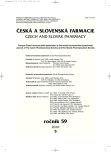A study of dissolution profiles of tramadol hydrochloride from the dosage forms with controlled release of the matrix and multiple unit types
Authors:
V. Kormanová 1; B. Vladovičová 1; Ž. Bezáková 3; M. Vítková 2; J. Škodová 1; Š. Zoričák 1; V. Hubinová 1; M. Rabišková 4; K. Dvořáčková 4
Authors‘ workplace:
Zentiva a. s., Hlohovec
1; Farmaceutická fakulta Univerzity Komenského v Bratislave, Katedra galenickej farmácie
2; Farmaceutická fakulta Univerzity Komenského v Bratislave, Katedra farmaceutickej chémie
3; Veterinární a farmaceutická univerzita Brno, Farmaceutická fakulta, Ústav technologie léků
4
Published in:
Čes. slov. Farm., 2010; 59, 210-218
Category:
Original Articles
Overview
The aim of the experimental paper was to evaluate the achieved retardation of prepared modified release formulations containing tramadol hydrochloride as an active ingredient by comparison of the dissolution profiles and to study the dissolution mechanism using mathematical models. The release of the active ingredient from the matrix tablet and multiple unit dosage form containing the coated microspheres was compared with the marketed once daily dosed modified release dosage forms of tramadol hydrochloride. The measured data were compared with the published pharmacokinetic data of available once daily formulations. Based on the evaluation of in vitro dissolution profiles, it can be assumed that the chosen formulations of matrix tablets using polyacrylate Eudragit NE 30 as a matrix-forming polymer and a pellet reservoir system containing the Kollicoat SR membrane allow to achieve the pharmacokinetic profile complying with the requirements for the dosage form of tramadol hydrochloride assuring a 24-hours prolonged effect of the active ingredient. The dissolution method employed is able to yield the results corresponding with the published data and predicting the differences in pharmacokinetic profiles described in the literature 4–6).
Key words:
tramadol hydrochloride – dissolution profile – dissolution mechanism – modified release
Sources
1. Beneš, L., Borovanský, A.: Farmaceutická chemie. Léčiva s účinkem na centrální (2. část) a periferní nervový systém. Veterinárna a farmaceutická univerzita Brno 1999; s. 36–37.
2. Rang, H. P., Dale, M. M., Ritter, J. M., Flower, R. J.: RANG and DALEęS Pharmacology. 6th ed. Elsevier Limited 2007; s. 605 a 607.
3. Lintz, W., Barth, H., Osterloh, G., et al.: Bioavailability of enteral Tramadol formulations: 1 st communication: capsules. Arzneimittelforschung, 1986; 36, 1278–1283.
4. Malonne, H., Sonet, B., Streel, B., et al.: Pharmacokinetic evaluation of a new oral sustained release dosage form of tramadol. Br J Clin Pharmacol., 2004; 257, 270–278.
5. Hernandez-Lopez, C., Martinez-Fanos, L., Karhu, D., Perez-Campos, T., Rovira, S., Encina, G.: Comparative Bioavailability Between Two Tramadol Once – Daily Oral Formulations. Methods Find Exp. Clin. Pharmacol., 2006; 28, 373–378.
6. Traynor, M. J., Brown, M. B., Pannala, A., Beck, P., Martin, G. P.: Influence of Alcohol on the Release of Tramadol from 24-h Controlled-Release Formulations During In Vitro Dissolution Experiments. School of Pharmacy, University of Hertfordshire, Hatfield, Hertfordshire, UK. Drug Dev. Ind. Pharm., 2008; 34, 885–889.
7. Cnota, P. J., Nowak, H., Tagarro, I., Erb, K., Schurer, M., Schulz, H. U., Maus, J.: Tramadol SR Formulations – Pharmacocinetic Comparison of a Multiple-Units Dose (Capsules) versus a Single – Unit Dose (Tablet). Clin. Drug Invest., 2005; 25, 435–443.
8. Aulton, M. E.: Pharmaceutics the science of dosage form design. Edinburgh: Churchill Livingstone 1988; 316.
9. Higuchi, T.: Mechanism of sustained – action medication: theoretical analysis of rate of releaseof solid drugs dispersed in solid matrices. J Pharm Sci., 1963; 52, 1145–1149.
10. Hixson, A. W., Crowell, J. H.: Dependence of reaction velocity uppon surface and agitation (I) theoretical consideration. Ind. Eng. Chem., 1931; 23, 923–931.
11. Korsmeyer, R. W., Lustig, S. R., Peppas, N. A.: Solute and penetrant diffusion in swellable polymers. I. Mathematical modeling. J. Polym. Sci Polym. Phys. Ed., 1986; 24, 395–408.
12. Korsmeyer, R. W., Von Meerwall, E., Peppas, N. A.: Solute and penetrant diffusion in swellable polymers. II. Verification of theoretical models. J. Polym. Sci Polym. Phys. Ed., 1986; 24, 409–434.
13. Európsky liekopis. European Pharmacopeia, 6th edition, 2010 (6.7) Counsel of Europe, Strasbourgh, s. 4344–4346 (13a), s. 3104–3106 (13b), s. 5091–5100 (13c).
14. Tiwari, S. B., Murthy, T. K., Pai, M. R., Metha, P. R., Chowdary, P. B.: Controlled Release Formulation of Tramadol Hydrochloride Using Hydrophilic and Hydrophobic Matrix System. AAPS Pharm SciTech., 2003; 4, article 31.
Labels
Pharmacy Clinical pharmacologyArticle was published in
Czech and Slovak Pharmacy

2010 Issue 5
Most read in this issue
- A study of dissolution profiles of tramadol hydrochloride from the dosage forms with controlled release of the matrix and multiple unit types
-
Medicinal preparations in the Renovated Prague Dispensatory of 1750
Part I – Introduction and the first nine classes of dosage forms -
Obsahové látky
Philadelphus coronarius L. -
Medicinal preparations in the Restored Prague Dispensatory of 1750
Part II – The examination of the remaining dosage forms
